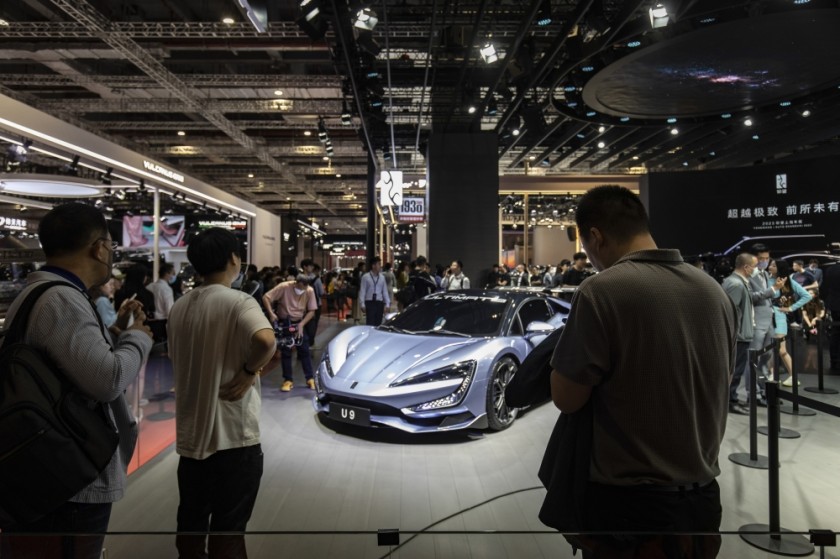

China’s BYD was a battery manufacturer trying its hand at building cars when it showed off its newest model in 2007. American executives at the Guangzhou auto show gaped at the car’s uneven purple paint job and the poor fit of its doors. “They were the laughingstock of the industry,” said Michael Dunne, a China auto industry analyst. Nobody is laughing at BYD now.
The company passed Tesla in worldwide sales of fully electric cars late last year. BYD is building assembly lines in Brazil, Hungary, Thailand and Uzbekistan and preparing to do so in Indonesia and Mexico. It is rapidly expanding exports to Europe. And the company is on the cusp of passing Volkswagen Group, which includes Audi, as the market leader in China.

BYD’s sales, over 80 per cent of them in China, have grown by about 1 million cars in each of the past two years. The last automaker to accomplish that in even one year in the American market was General Motors — and that was in 1946, after GM had suspended passenger car sales during the four preceding years because of World War II.
“BYD’s growth is unlike anything the industry has seen in many decades,” said Matt Anderson, curator of transportation at the Henry Ford Museum in Dearborn, Michigan. Based in Shenzhen, the hub of China’s electronics industry, BYD has shown how Chinese carmakers can tap the country’s dominance of electrical products. No company has benefited as much from China’s embrace of battery-electric cars and plug-in gasoline-electric cars. These vehicles together make up 40 per cent of China’s car market, the world’s largest, and are expected to be more than half next year. Like most Chinese automakers, BYD doesn’t sell its cars in America because Donald Trump-era tariffs remain in place, but BYD does sell buses in the United States.

BYD is leading China’s export push in electric cars, and is rapidly building the world’s largest car carrier ships to transport them. The first of the ships, the BYD Explorer No. 1, is on its maiden voyage from Shenzhen with 5,000 electric cars on board, and is expected to arrive in the Netherlands by Feb. 21.
With China’s and BYD’s success has come more scrutiny. Elon Musk, CEO of Tesla, warned about the strength of Chinese electric car exports in a company earnings call in January. “Frankly, I think if there are not trade barriers established, they will pretty much demolish most other companies in the world,” he said.
BYD’s chair, Wang Chuanfu, founded the company in 1995 to make batteries for Motorola and other consumer electronics companies. He had studied at Central South University in Changsha, an elite institution famed for battery chemistry research. But he dreamed of making cars. In 2003, BYD bought a factory in Xi’an that was building gasoline-powered cars. But the company had trouble at the start, gaining an early reputation for building clunkers. In a visit to the factory in 2006, a large repair area at the end of the assembly line was clogged with newly built cars that already needed more work.
BYD’s sales grew as the Chinese market soared. Warren Buffett bought a nearly 10 per cent stake for $230 million in 2008, giving BYD not just a cash infusion but also global cachet. The same year, Wang promised to start exporting battery-electric cars to the United States within two years. But electric cars at the time cost a lot to build and had limited range, and Wang had to scotch his plans to enter the American market. In an interview in 2011, he second-guessed his emphasis on battery-electric cars. Automakers should focus on gasoline-electric hybrids, he declared. He added, “There is still tremendous potential in the Chinese market for electric cars.” By 2012, car production in China had caught up with demand. Buyers became choosier. BYD’s car sales and stock price plunged as multinationals offered more stylish models. Industry executives and analysts questioned whether BYD had a future.
But Wang proceeded to make two risky bets that paid off. In 2016, he hired Wolfgang Egger, a prominent Audi designer, who in turn hired hundreds more car engineers with bold tastes. They completely redesigned BYD’s models. Wang also figured out how to replace the industry’s standard chemicals in rechargeable lithium batteries — nickel, cobalt and manganese — with cheaper iron and phosphate. But early batteries made from the inexpensive chemical compounds ran out of juice quickly and had to be recharged after even short trips.

In 2020, BYD introduced its Blade batteries, which closed most of the so-called range gap with nickel-cobalt batteries at a fraction of what they cost.
Tesla began making and selling large numbers of cars in China the same year, and enthusiasm for electric cars swept the nation. BYD was ready with inexpensive battery chemistries and Egger’s new designs. Tesla also began using lithium iron phosphate batteries in less expensive models. BYD still sells mostly cheaper cars with lower range, while Tesla mostly sells costlier cars with more range.
BYD now has its own walled town in Shenzhen, a southeastern city next to Hong Kong. An airport-style monorail carries workers from 18-story company apartments to BYD’s office towers and research labs. Liu Qiangqiang, an engineer at the Shenzhen center, said the staff of his car development team had almost tripled since he joined the company from GMs 15 months ago. “The pace is fast,” he said. — The New York Times.
Oman Observer is now on the WhatsApp channel. Click here



